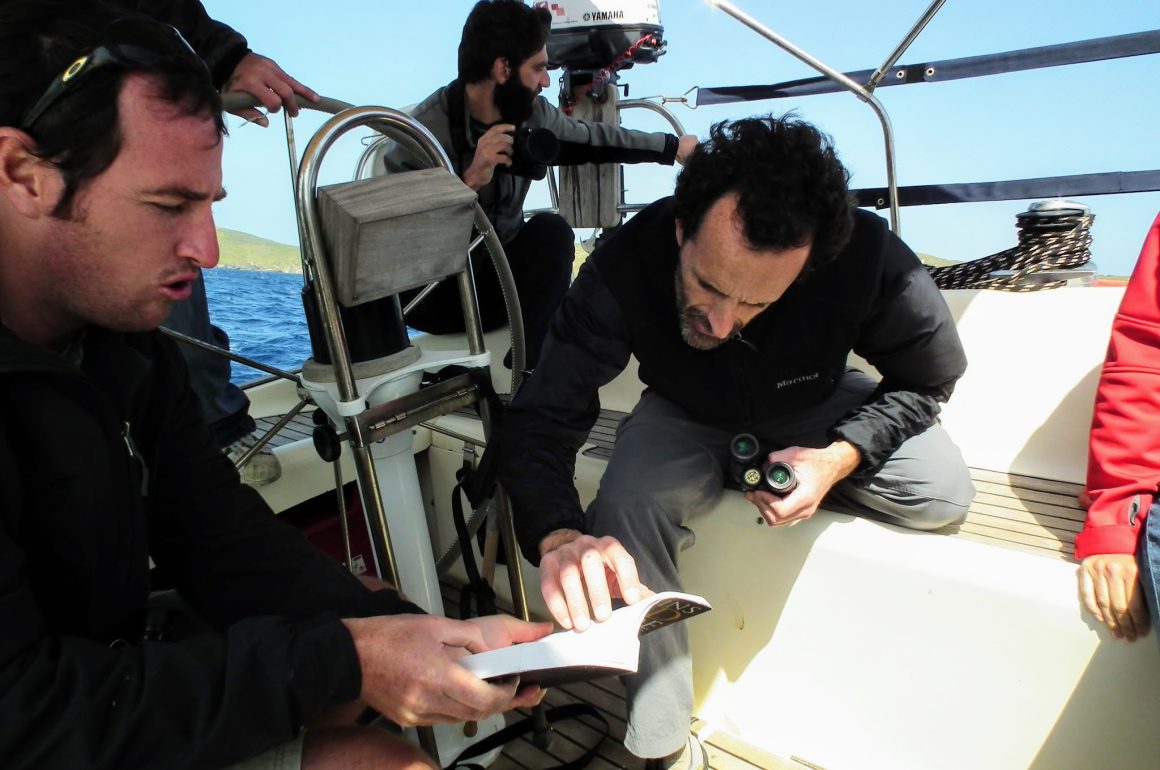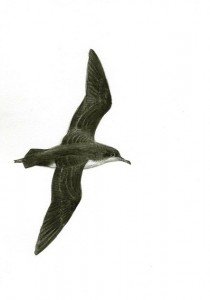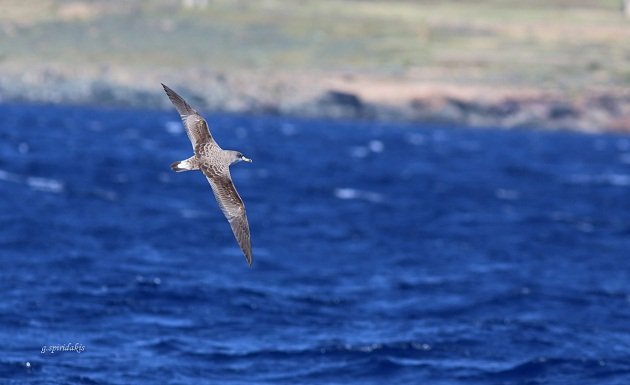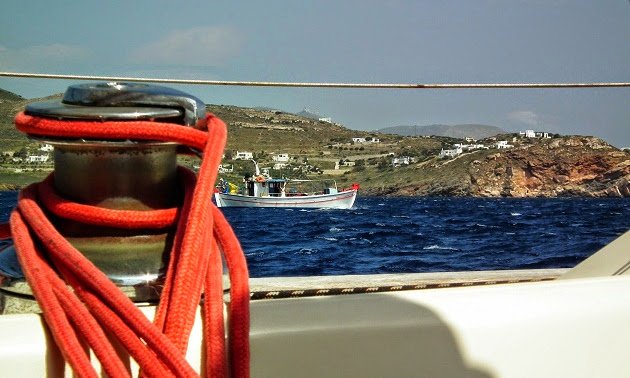
I am half-awake, but keep my eyes closed. Listening to the wheeping of stays and shrouds and screeching of fenders against the next sailboat, I do not want to wake up. Still, we are sailing out of the marina soon and I should have some coffee before that. We are in the village of Finikas on the island of Syros in the Cyclades archipelago of Greece. A range of hills protects the cove from the eastern wind, yet, the bushes are swaying in the rythm of it.
Leaving the marina and turning off the engine, turning off the vibrations… The only sound becomes wind in the sails, wind in my ears. There is about 4 Beauforts of it, a bit too much for the blessed silence I was looking for. My last sailing trip was some three decades ago and my best day was the adrenaline filled one when we were going against the wind and straight into the waves. Nowadays, almost half a century old, I prefer calmer seas and milder winds and still assure myself that it’s not the years, but the mileage.
Yellow-legged Gulls above us, one European Shag flying low against the cliffs and a small flock of the largest of local swits – Alpine, above them. For some reason I cannot explain – I was perfectly sober, the words ”Hee roar, up she rouses, What shall we do with the drunken sailor?“ were ringing in my wind-swept head.
We sail into the relative calm of a cliff, the mast takes an upright position, navigation becomes calm and quiet… quiet enough for our bird guide, Andrea Bonetti to pick up a voice of a Western Rock Nuthatch coming from the rock face. We come closer to it, but I cannot find the bird with binoculars. Nick finds a bird-shaped protrusion at the top of the rock – Black-eared Wheatear, not exactly a species I expect to observe from a boat deck. We are looking for shags and shearwaters, as well as some rarer gulls that didn’t bother to show up. A few weeks from now (it was early April), Eleonora’s Falcons will become a possibility, too, once they return from Madagascar. A movement at the cliff, two birds, one drab brown, the other blue – a pair of Blue Rock Thrushes.
Ho! Ho! and up she rises,
Early in the morning.
 Yelkouan Shearwater (c) Paschalis Dougalis
Yelkouan Shearwater (c) Paschalis Dougalis
Andrea now spreads the genoa, we go against the easterly and the boat lies to its side. Off to the nearest kaiki (traditional Greek fishing boat) followed by a flock of shearwaters and gulls. Even before we come close, we find our first threatened Yelkouan Shearwater.
This shearwater is a Mediterranean endemic, breeding from Sardinia and Corsica to the Adriatic and the Aegean. In the IUCN Red List, it is listed as vulnerable because of the high mortality of nestlings that become victims to rats and of adults that end up as a fishery bycatch. Tha dropping numbers are suspected in Greece and Croatia, and confirmed in Italy, France and Malta.
But, the Yelkouan Shearwater is also a lifer for me! Since it almost shears water with its wingtips and I am sitting at the lower side of a tilted boat, I am not watching it from a high deck, as recommended for sea watching, but from the same height. That also means I am not watching it against the dark blue of the sea, but sharply silhouetted against the sunny sky.
We are getting closer to a kaiki and I enjoy the hungry flock trying to snatch its lunch from the net. Beside a few Yellow-legged Gulls, the rest consist of three dozen Scopoli’s Shearwater, a race of Cory’s Shearwater (Calonectris d. diomedea).
 Scopoli’s Shearwater (c) Georgos Spiridakis
Scopoli’s Shearwater (c) Georgos Spiridakis
On our way back, three Common Bottlenose Dolphins show right next to the boat and, some time later, a Painted Lady (Vanessa cardui) butterfly appears some 300 metres downwind from the shore. I asked if the butterfly stood a chance of returning to the shore, to find out that it is a long range migrant, braving the winds of the North Atlantic while traveling all the way from Africa to Iceland!
After a light seafood lunch and some local brew, we went to the hills surrounding the Finikas. I was hoping for a Chukar; that would make another lifer for me. It lives from the Peloponnese and the Aegean Islands across the whole of Asia to the shores of the East China Sea and here I stand at the very edge of the range of this species.
Above us is a hill slope with some rocky outcrops, overgrown in low shrubs, plus electric lines, always helpful when one wants to spot some passerines. Below us is a luxuriant villa that appears devoid of any life, yet hardly audible music comes from it, most likely to deter prospective thieves. Scanning the bushes towards the villa… nope. There are no Chukars.
The electric lines are adorned with two dozen Common Linnets and a few European Goldfinches, while further away one Common Kestrel is checking some prey. And the sky is full of birds: a hundred or more Barn Swallows, a few dozen each of Red-rumped Swallows and Common House Martins, plus a few Pallid and Common Swifts.
The Sun already sets and I haven’t seen a new species in a while. And then, from somewhere behind my back, a strange voice – chakera-chakera-chakera – I had never heard this call and yet, immediately thought “This must be a Chukar!” Turning around to see the already deeply shadowed slope and the bright reflection of a setting Sun in the sea and, against it, the silhouette of a cock calling: chakera-chakera-chakera! What a nice bird, I think to myself, if it hadn’t called, I would not have seen it.
Still, the call was not aimed at me. Somewhere from the slope below the cock, the hen responds with: chak chak. She does not sound overly excited. Hastily, I search the slope… there she is, walking into that bush. A few noisy wingbeats to take off and the cock glides down to her.
Gosh! I am observing a Chukar date! The cock lands behind a palm tree in the villa garden, to avoid prying binoculars, I suppose. Barely audible music comes from the villa. I cannot say for sure, but it did sound like…
Mamma mia, here I go again
My my, how can I resist you?
Practicalities
 I was on a new sailing birdwatch tour well organised by Natural Greece and accompanied by their bird guide Andrea Bonetti. At the island of Syros, we slept on a Jeanneau Sun Kiss 45 sloop. It has a spacious salon and two tiny bathrooms. Cabins are adequate, but compact. If you share it with someone, you better love that person. Try to carry your stuff in a duffel bag that you can push into a small wardrobe. I used airplane cabin-size suitcase (it worked for me), although, to spare on the floor space, I’ve kept it upright, on its four wheels. It must have made quite a mileage while we were sailing on those waves. As air carriers, to Athens and back from Syros to Athens I used the Aegean Airlines and later, from Thessaloniki, Air Serbia.
I was on a new sailing birdwatch tour well organised by Natural Greece and accompanied by their bird guide Andrea Bonetti. At the island of Syros, we slept on a Jeanneau Sun Kiss 45 sloop. It has a spacious salon and two tiny bathrooms. Cabins are adequate, but compact. If you share it with someone, you better love that person. Try to carry your stuff in a duffel bag that you can push into a small wardrobe. I used airplane cabin-size suitcase (it worked for me), although, to spare on the floor space, I’ve kept it upright, on its four wheels. It must have made quite a mileage while we were sailing on those waves. As air carriers, to Athens and back from Syros to Athens I used the Aegean Airlines and later, from Thessaloniki, Air Serbia.
The BirdLife Greece has recently published the Greek bird finder, available online as pdf and downloadable as an android smartphone application.
In the next post: the pelican-covered lake Karkini.
In the previous post: the outskirts of Athens.













Leave a Comment